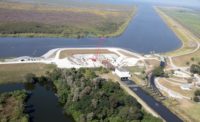The U.S. Geological Survey detected changes in groundwater salinity near Florida's Lake Okeechobee following construction of a seepage barrier along the southeastern quarter of the lake. Contractors working for the U.S. Army Corps of Engineers built a cutoff wall to divert the path of water seepage discovered after hurricanes in 2004 and 2005. The flow damaged the 143-mile-long Herbert Hoover Dike, built in the 1930s around the lake for flood control.
Seepage of this sort is responsible for about 20% of dam failures in the U.S., according to the Association of State Dam Safety Officials. In 2007, the Corps listed the dike on a list of dams most at risk and requiring urgent repairs.
The groundwater findings are detailed in a Feb. 24 USGS report. Since 2011, USGS and the Corps have monitored groundwater at 10 sites in a 60-mile-long span sited 80 ft to 1,550 ft distant from the dike to evaluate changes that might be related to the repair.
The saline water probably is the remnant of seawater that flooded the area between 120,000 and 5 million years ago, says June Mirecki, a hydrogeologist with the Corps. Saltwater is heavier than freshwater, so it lies at the bottom of the aquifer, with a freshwater layer on top. Monitoring wells detected minor changes in salinity levels at all of the locations, but saltwater upwelling from deeper in the aquifer occurred only along the dike where the seepage barrier was installed. As a result, the saltwater rose higher in monitoring wells, leaving less freshwater on top. At one location, the depth of the saltwater became shallower by 19 ft, resulting in a 60-ft-deep monitoring well that had previously yielded freshwater beginning to yield salty water.
"We don't have anybody to date who has complained about a groundwater quality issue associated with our well installation," says Mark Shafer, a senior environmental engineer with the Corps. "We've seen some evidence that the water quality is changing but also that those changes are slowing down. There's also evidence at some locations that water quality is improving at certain depths in certain wells."
In some areas, the evidence suggests that the groundwater may be reaching a new steady-state condition, he says.
The barrier, a wall of grout 50-70 ft deep, has been completed on a 21.4-mile stretch of the dike between Port Mayaca and Belle Glade, says Tim Willadsen, the Corps' project manager for Herbert Hoover Dike rehabilitation.
Three separate contractors—Hayward Baker Inc., Bauer Foundations Corp. and Treviicos South Inc.—performed the work from 2007 to 2013 under multiple-award task order contracts at a total cost of $220 million.
No barrier construction is currently under way, but a 6.8-mile-long section on the south shore of the lake with an estimated cost of $75 million is being planned. The Corps likely will issue a request for proposals with a firm fixed price, Willadsen says. He expects the work to be approved this summer and funded in fiscal 2017. "Anything beyond what we've already done and what we're planning to do on this segment in the south is going to be dependent on the results of the ongoing dam safety modification study," which includes the entire Lake Okeechobee embankment, says Willadsen.



Post a comment to this article
Report Abusive Comment